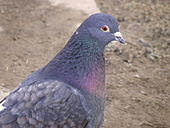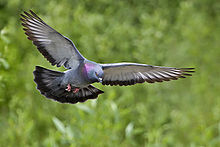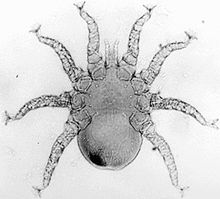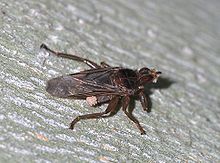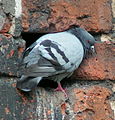- Rock Pigeon
-
For other uses, see Rock Pigeon (disambiguation).
Rock Pigeon 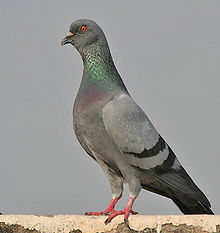
Adult C. l. intermedia in India Conservation status Scientific classification Kingdom: Animalia Phylum: Chordata Class: Aves Order: Columbiformes Family: Columbidae Genus: Columba Species: C. livia Binomial name Columba livia
Gmelin, 1789[2]
Distribution The Rock Dove[3] (Columba livia) or Rock Pigeon, is a member of the bird family Columbidae (doves and pigeons).[4] In common usage, this bird is often simply referred to as the "pigeon". The species includes the domestic pigeon (including the fancy pigeon), and escaped domestic pigeons have given rise to feral populations around the world.[5]
Wild Rock Doves are pale grey with two black bars on each wing, although domestic and feral pigeons are very variable in colour and pattern. There are few visible differences between males and females.[6] The species is generally monogamous, with two squeakers (young) per brood. Both parents care for the young for a time.[7]
Habitats include various open and semi-open environments. Cliffs and rock ledges are used for roosting and breeding in the wild. Originally found wild in Europe, North Africa, and western Asia, feral Pigeon have become established in cities around the world. The species is abundant, with an estimated population of 17 to 28 million feral and wild birds in Europe.[1]
Contents
Taxonomy and naming
The Rock Dove was first described by Gmelin in 1789.[citation needed] The genus name Columba is the Latinized form of the Ancient Greek κόλυμβος (kolumbos), "a diver", from κολυμβάω (kolumbao), "dive, plunge headlong, swim".[8] Aristophanes (Birds, 304) and others use the word κολυμβίς (kolumbis), "diver", for the name of the bird, because of its swimming motion in the air. The specific epithet is derived from the Latin livor, "bluish".[9] Its closest relative in the Columba genus is the Hill Pigeon, followed by the other rock pigeons: the Snow, Speckled and White-collared Pigeons.[4]
The species is also known as the Rock Pigeon or Blue Rock Dove, the former being the official name from 2004 to 2011, at which point the IOC changed their official listing to its original British name of Rock Dove.[3][10] In common usage, this bird is still often simply referred to as the "pigeon". Baby pigeons are called squabs.[7]
Subspecies
There are 12 subspecies recognised by Gibbs (2000); some of these may be derived from feral stock.[4]
- C. l. livia, the nominate subspecies, occurs in western and southern Europe, northern Africa, and Asia to western Kazakhstan, the northern Caucasus, Georgia, Cyprus, Turkey, and Iraq.
- C. l. atlantis (Bannerman, 1931) of Madeira, the Azores and Cape Verde, is a very variable population with chequered upperparts obscuring the black wingbars, and is almost certainly derived from feral pigeons.
- C. l. canariensis (Bannerman, 1914) of the Canary Islands, is smaller and averages darker than the nominate subspecies.
- C. l. gymnocyclus (Gray, 1856) from Senegal and Guinea to Ghana and Nigeria is smaller and very much darker than nominate C. l. livia. It is almost blackish on the head, rump and underparts with a white back and the iridescence of the nape extending onto the head.
- C. l. targia (Geyr von Schweppenburg, 1916) breeds in the mountains of the Sahara east to Sudan. It is slightly smaller than the nominate form, with similar plumage, but the back is concolorous with the mantle instead of white.
- C. l. dakhlae (Richard Meinertzhagen, 1928) is confined to the two oases in central Egypt. It is smaller and much paler than the nominate subspecies.
- C. l. schimperi (Bonaparte, 1854) is found in the Nile Delta south to northern Sudan. It closely resembles C. l. targia, but has a distinctly paler mantle.
- C. l. palaestinae (Zedlitz, 1912) occurs from Syria to Sinai and Arabia. It is slightly larger than C. l. schimperi and has darker plumage.
- C. l. gaddi (Zarodney & Looudoni, 1906), breeds from Azerbaijan and Iran east to Uzbekistan is larger and paler than C. l. palaestinae with which it intergrades in the west. It also intergrades with the next subspecies to the east.
- C. l. neglecta (Hume, 1873), is found in the mountains of eastern Central Asia. It is similar to the nominate subspecies in size, but is darker with a stronger and more extensive iridescent sheen on the neck. It intergrades with the next race in the south.
- C. l. intermedia (Strickland, 1844) occurs in Sri Lanka and in India south of the Himalayan range of C. l. neglecta. It is similar to that subspecies, but darker with a less contrasting back.
- C. l. nigricans (Buturlin, 1908) in Mongolia and north China is variable and probably derived from feral stock.
Description
 The distinctive cere is located on top of the beak.
The distinctive cere is located on top of the beak.
The adult of the nominate subspecies of the Rock Dove is 32–37 cm (12–14½ in) long with a 64–72 cm (25–28 in) wingspan.[11] Weight for Rock Doves ranges from 238 to 380 grams (8.4-13.4 oz).[12] It has a dark bluish-gray head, neck, and chest with glossy yellowish, greenish, and reddish-purple iridescence along its neck and wing feathers. The iris is orange, red or golden with a paler inner ring, and the bare skin round the eye is bluish-grey. The bill is grey-black with a conspicuous off-white cere, and the feet are purplish-red.
The adult female is almost identical to the male, but the iridescence on the neck is less intense and more restricted to the rear and sides, while that on the breast is often very obscure.[4]
The white lower back of the pure Rock Dove is its best identification character, the two black bars on its pale grey wings are also distinctive. The tail has a black band on the end and the outer web of the tail feathers are margined with white. It is strong and quick on the wing, dashing out from sea caves, flying low over the water, its lighter grey rump showing well from above.[10]
Young birds show little lustre and are duller. Eye colour of the pigeon is generally orange but a few pigeons may have white-grey eyes. The eyelids are orange in colour and are encapsulated in a grey-white eye ring. The feet are red to pink.[7]
When circling overhead, the white underwing of the bird becomes conspicuous. In its flight, behaviour, and voice, which is more of a dovecot coo than the phrase of the Wood Pigeon, it is a typical pigeon. Although it is a relatively strong flier, it also glides frequently, holding its wings in a very pronounced V shape as it does. Though fields are visited for grain and green food, it is nowhere so plentiful as to be a pest.[13]
Pigeons feed on the ground in flocks or individually. They roost together in buildings or on walls or statues. When drinking, most birds take small sips and tilt their heads backwards to swallow the water. Pigeons are able to dip their bills into the water and drink continuously without having to tilt their heads back. When disturbed, a pigeon in a group will take off with a noisy clapping sound.[14]
Pigeons, especially homing or carrier breeds, are well known for their ability to find their way home from long distances. Despite these demonstrated abilities, wild Rock Doves are sedentary and rarely leave their local areas.[15]
Distribution and habitat
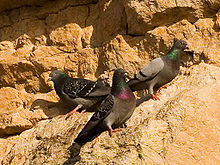 Feral Rock Doves in semi-natural habitat perched on sea cliffs
Feral Rock Doves in semi-natural habitat perched on sea cliffs
The Rock Dove has a restricted natural resident range in western and southern Europe, North Africa, and into South Asia. The Rock Dove is often found in pairs in the breeding season but is usually gregarious.[4] The species (including ferals) has a large range, with an estimated global extent of occurrence of 10 million km². It has a large global population, including an estimated 17–28 million individuals in Europe[1] Fossil evidence suggests the Rock Dove originated in southern Asia and skeletal remains unearthed in Israel confirm their existence there for at least three hundred thousand years.[5] However, this species has such a long history with humans that it's impossible to tell exactly where the species' original range was.[16] Its habitat is natural cliffs, usually on coasts. Its domesticated form, the feral pigeon, has been widely introduced elsewhere, and is common, especially in cities, over much of the world. A Rock Pigeon's life span is anywhere from 3–5 years in the wild to 15 years in captivity, though longer-lived specimens have been reported.[14] The species was first introduced to North America in 1606 at Port Royal, Nova Scotia.[10]
Reproduction
Courtship display
The Rock Dove breeds at any time of the year, but peak times are spring and summer. Nesting sites are situated along coastal cliff faces, as well as the artificial cliff faces created by apartment buildings with accessible ledges or roof spaces.[17]
The type of nest constructed is a flimsy platform of straw and sticks, put on ledge, under cover. Often window ledges of buildings.[15] Two white eggs are laid with incubation that is shared by both parents lasting from seventeen to nineteen days.[7]
The nestling has pale yellow down and a flesh-coloured bill with a dark band. It is tended and fed on "crop milk" like other doves. The fledging period is 30 days.[11]
Predators
Pigeons are preyed upon by many different predators with Peregrine Falcons and Sparrowhawks being quite adept at catching and feeding upon this species, as shown by the high losses of racing pigeons to these predators.[18] Some common predators of feral pigeons in the North America are Opossums, Raccoons, Great Horned Owls, and Eastern Screech-owls. Other predators include the Golden Eagle and American Kestrels.[19] On the ground the adults, their young and their eggs are at risk from feral and domestic cats.[7] Doves and pigeons are considered to be game birds as many species have been hunted and used for food in many of the countries in which they are native.[20]
Parasites
Pigeons may harbour a diverse parasite fauna.[21] They often host the intestinal helminths Capillaria columbae and Ascaridia columbae. Their ectoparasites include the Ischnoceran lice Columbicola columbae, Campanulotes bidentatus compar, the Amblyceran lice Bonomiella columbae, Hohorstiella lata, Colpocephalum turbinatum, the mites Tinaminyssus melloi, Dermanyssus gallinae, Dermoglyphus columbae, Falculifer rostratus, and Diplaegidia columbae. The hippoboscid fly Pseudolynchia canariensis is a typical blood-sucking ectoparasite of pigeons, found only in tropical and sub-tropical regions.
Human health
Pigeons have been falsely associated with the spread of human diseases. [22][verification needed] Contact with pigeon droppings poses a minor risk of contracting histoplasmosis, cryptococcosis, and psittacosis.[23] Pigeons are not a major concern in the spread of West Nile virus; though they can contract it, they do not appear to be able to transmit it.[24] Pigeons are, however, at potential risk for carrying and spreading avian influenza. Although one study has shown that adult pigeons are not clinically susceptible to the most dangerous strain of avian influenza, the H5N1,[25] other studies have presented definitive evidence of clinical signs and neurological lesions resulting from infection.[26][27] Furthermore, it has been shown that pigeons are susceptible to other strains of avian influenza, such as the H7N7,[28] from which at least one human fatality has been recorded.
Domestication
Main article: Domestic pigeonRock Doves have been domesticated for several thousand years, giving rise to the domestic pigeon (Columba livia domestica).[7] As well as pets, domesticated pigeons are utilised as homing pigeons and carrier pigeons, and so-called war pigeons have served and played important roles during wartimes, with many pigeons having received bravery awards and medals for their services in saving hundreds of human lives: including, notably, the British pigeon Cher Ami who received the Croix de Guerre for his heroic actions during World War I, and the Irish Paddy and the American G.I. Joe, who both received the Dickin Medal, amongst 32 pigeons to receive this medallion, for their gallant and brave actions during World War II.[7] There are numerous breeds of fancy pigeons of all sizes, colours and types.[29]
Feral pigeon
Main article: Feral PigeonMany domestic birds have escaped or been released over the years, and have given rise to the feral pigeon. These show a variety of plumages, although some have the blue barred pattern like the pure Rock Dove does. Feral pigeons are found in large numbers in cities and towns all over the world.[30] The scarcity of the pure wild species is partly due to interbreeding with feral birds.[13]
Gallery
References
- ^ a b c BirdLife International (2004). Columba livia. 2006. IUCN Red List of Threatened Species. IUCN 2006. www.iucnredlist.org. Retrieved on 8 May 2006.
- ^ "Columba livia Gmelin, 1789" (Web data). ITIS Report. http://www.itis.gov/servlet/SingleRpt/SingleRpt?search_topic=TSN&search_value=177071. Retrieved 2008-02-23.
- ^ a b ENGLISH NAME UPDATES - IOC Version 2.9 (July 10, 2011), IOC World Bird List
- ^ a b c d e Gibbs, David; Eustace Barnes, John Cox. Pigeons and Doves: A Guide to the Pigeons and Doves of the World. United Kingdom: Pica Press. pp. 624. ISBN 1873403607. http://books.google.com/?id=aeZXAAAACAAJ&dq=Pigeons+and+Doves:+A+Guide+to+the+Pigeons+and+Doves+of+the+World.
- ^ a b Blechman, Andrew (2007). Pigeons-The fascinating saga of the world's most revered and reviled bird.. St Lucia, Queensland: University of Queensland Press. ISBN 9780702236419. http://andrewblechman.com/pigeons/learn_more.html.
- ^ "Rock Pigeon". Cornell lab of ornithology – All about birds. 2003. http://www.birds.cornell.edu/AllAboutBirds/BirdGuide/Rock_Pigeon_dtl.html. Retrieved 2008-04-29.
- ^ a b c d e f g Levi, Wendell (1977). The Pigeon. Sumter, S.C.: Levi Publishing Co, Inc. ISBN 0853900132.
- ^ Liddell, Henry George and Robert Scott (1980). A Greek-English Lexicon (Abridged Edition). United Kingdom: Oxford University Press. ISBN 0-19-910207-4.
- ^ Simpson, D.P. (1979). Cassell's Latin Dictionary (5 ed.). London: Cassell Ltd.. pp. 883. ISBN 0-304-52257-0.
- ^ a b c White, Helen. "Rock Pigeon Columba livia (Gmelin, 1789)" (Web article). Diamond Dove homepage. http://www.diamonddove.info/bird14%20Rock%20Dove.htm. Retrieved 2008-02-18.
- ^ a b Jahan, Shah. "Feral Pigeon" (Web article). The Birds I Saw. http://www.fsquares.com/bis/Bird.aspx?q=15. Retrieved 2008-02-19.
- ^ Rock Pigeon All About Birds
- ^ a b Wright, Mike. "Wildlife Profiles: Pigeon" (Web article). Arkansas Urban Wildlife. http://www.arkansasurbanwildlife.com/wildlife/pigeon.aspx. Retrieved 2008-02-18.
- ^ a b "Columba livia (domest.)" (Web article). BBC Science & Nature. http://www.bbc.co.uk/nature/wildfacts/factfiles/3030.shtml. Retrieved 2008-02-19.
- ^ a b "Rock Pigeon" (Web article). Cornell Laboratory of Ornithology. http://www.birds.cornell.edu/AllAboutBirds/BirdGuide/Rock_Pigeon_dtl.html. Retrieved 2008-02-19.
- ^ Rock Pigeon All About Birds
- ^ "Columba livia" (Web article). Australian Museum Online. http://www.amonline.net.au/factSheets/rock_dove.htm. Retrieved 2008-02-18.
- ^ Brown, Angie. "Birds of prey 'will kill off pigeon racing'" (Web article). The Scotsman. http://news.scotsman.com/birdsofprey/Birds-of-prey-will-kill.2656902.jp. Retrieved 2008-02-20.
- ^ Roof, Jennifer (2001). "Columba livia common pigeon" (Web article). Animal Diversity Web University of Michigan. http://animaldiversity.ummz.umich.edu/site/accounts/information/Columba_livia.html. Retrieved 2008-02-20.
- ^ Butler, Krissy Anne. "Keeping & Breeding Doves & Pigeons" (Web article). Game Bird Gazette Magazine. http://www.gamebird.com/dove.html. Retrieved 2008-02-23.
- ^ Rózsa L (1990). "The ectoparasite fauna of feral pigeon populations in Hungary". Parasitologia Hungarica 23: 115–119. http://www.zoologia.hu/list/pigeon.pdf.
- ^ "Pigeons and Public Health - The TRUE Facts" (Web article). The Urban Wildlife Society. http://www.urbanwildlifesociety.org/zoonoses/ExprtsRePijZoonos.html. Retrieved 2009-03-05.
- ^ "Facts about pigeon-related diseases" (Web article). The New York City Department of Health and Mental Hygiene. http://www.nyc.gov/html/doh/html/epi/epi-pigeon.shtml. Retrieved 2009-03-05.
- ^ Chalmers, Dr Gordon A. "West Nile Virus and Pigeons" (Web article). Panorama lofts. Archived from the original on 2009-10-26. http://www.webcitation.org/query?url=http://www.geocities.com/panoramalofts/gchf08.html&date=2009-10-26+00:11:01. Retrieved 2008-02-18.
- ^ Liu Y, Zhou J, Yang H, et al. (2007 bum). "Susceptibility and transmissibility of pigeons to Asian lineage highly pathogenic avian influenza virus subtype H5N1". Avian Pathol. 36 (6): 461–5. doi:10.1080/03079450701639335. PMID 17994324.
- ^ Klopfleisch R, Werner O, Mundt E, Harder T, Teifke JP (2006). "Neurotropism of highly pathogenic avian influenza virus A/chicken/Indonesia/2003 (H5N1) in experimentally infected pigeons (Columbia livia f. domestica)". Vet. Pathol. 43 (4): 463–70. doi:10.1354/vp.43-4-463. PMID 16846988.
- ^ Werner O, Starick E, Teifke J, et al. (2007). "Minute excretion of highly pathogenic avian influenza virus A/chicken/Indonesia/2003 (H5N1) from experimentally infected domestic pigeons (Columbia livia) and lack of transmission to sentinel chickens". J. Gen. Virol. 88 (Pt 11): 3089–93. doi:10.1099/vir.0.83105-0. PMID 17947534.
- ^ Panigrahy B, Senne DA, Pedersen JC, Shafer AL, Pearson JE (1996). "Susceptibility of pigeons to avian influenza". Avian Dis. 40 (3): 600–4. doi:10.2307/1592270. JSTOR 1592270. PMID 8883790.
- ^ McClary, Douglas (1999). Pigeons for Everyone. Great Britain: Winckley Press. ISBN 0907769284.
- ^ "Why study pigeons? To understand why there are so many colors of feral pigeons" (Web Article). Cornell Lab of Ornithology. http://www.birds.cornell.edu/programs/urbanbirds/about/ubs_PIWWhyStudyEN.html. Retrieved 2008-02-20.
Categories:- IUCN Red List least concern species
- Columba
- Cosmopolitan species
- Domesticated birds
- Introduced birds
- British Isles coastal fauna
- Birds of Africa
- Birds of Canada
- Birds of Europe
- Birds of North America
- Birds of New Zealand
- Birds of Russia
- Birds of Turkey
- Birds of Pakistan
- Birds of India
- Invasive animal species in the United States
- Animals described in 1789
Wikimedia Foundation. 2010.


